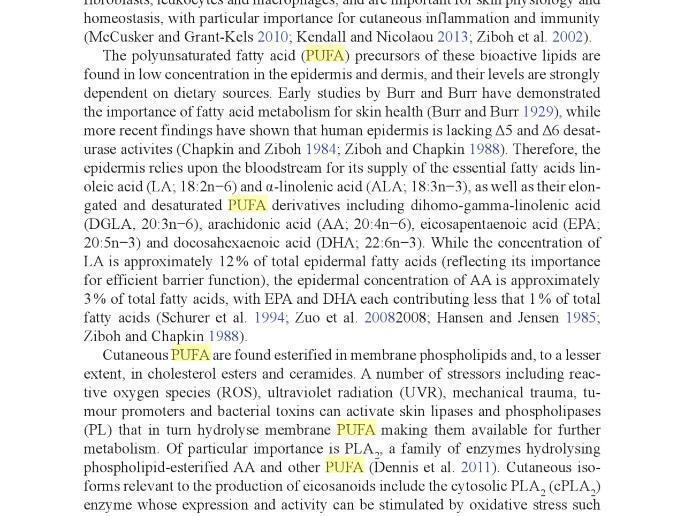I found this extract of the book "Lipids and Skin Health" from biochemist and skin researcher, Apostolos Pappas

This books is serious stuff, sadly its so expensive to buy and read it; but sure it provides very deep insightful knowledge on skin metabolism.
I think dietary pufas have functional use in some amounts, but the "pufa depletion" idea may not always be the way to go. Just like iron, we need a minimum level to avoid anemia, but to minimize storage accumulation too. PUFA may be the same, specially LA. The concept of cutting PUFAs in modern occidental diets is obviously a must in terms of health; but trying to deplete cutting it too drastically is another thing.
Maybe the ideal is to prevent it to accumulate it but not at the cost of reducing it that much, the same as iron. Skin health -the whole organ- is one of the best and most importants mirror of health.
PUFA's in breast milk (LA accounting for 90% of it) averages 12% (which matches that of the skin) of total fatty acids. Why not take that as reference? Sure cutting PUFAs all the possible has some benefits, specially for overweight people (+20% bf) with high pufa storage; but trade-offs too looking at epidermis layers innate composition.
But for a lean person, being around 10% bf, woulnd't be prudent to stick closer to the breast milk ratio? Before you answer I will refresh two famous quotes:
1. "We don't know a millionth of one percent about anything." - Thomas A. Edison.
2. "Don't put all your eggs in one basket." - Ancient proverb.

This books is serious stuff, sadly its so expensive to buy and read it; but sure it provides very deep insightful knowledge on skin metabolism.
I think dietary pufas have functional use in some amounts, but the "pufa depletion" idea may not always be the way to go. Just like iron, we need a minimum level to avoid anemia, but to minimize storage accumulation too. PUFA may be the same, specially LA. The concept of cutting PUFAs in modern occidental diets is obviously a must in terms of health; but trying to deplete cutting it too drastically is another thing.
Maybe the ideal is to prevent it to accumulate it but not at the cost of reducing it that much, the same as iron. Skin health -the whole organ- is one of the best and most importants mirror of health.
PUFA's in breast milk (LA accounting for 90% of it) averages 12% (which matches that of the skin) of total fatty acids. Why not take that as reference? Sure cutting PUFAs all the possible has some benefits, specially for overweight people (+20% bf) with high pufa storage; but trade-offs too looking at epidermis layers innate composition.
But for a lean person, being around 10% bf, woulnd't be prudent to stick closer to the breast milk ratio? Before you answer I will refresh two famous quotes:
1. "We don't know a millionth of one percent about anything." - Thomas A. Edison.
2. "Don't put all your eggs in one basket." - Ancient proverb.
Last edited:
